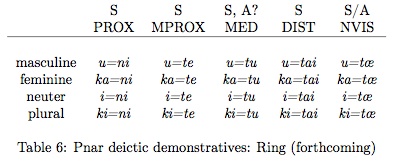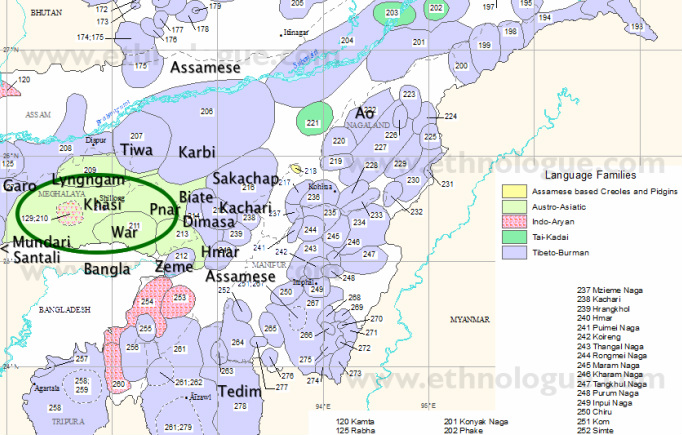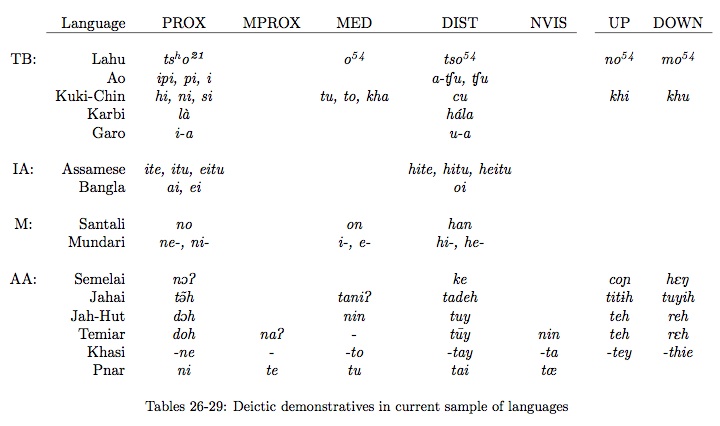
In my last post I discussed the concept of deixis and illustrated deictic demonstratives in Pnar. Pnar’s deictic demonstrative system combines gender clitics with largely distance-based deictic morphemes, so there are potentially twenty demonstrative forms that identify nominal distance in relation to the deictic center, which can be either Speaker or Addressee, depending on the context. I’m still trying to figure out which for some forms.
The subject of my HLS talk related the Pnar demonstrative system to the demonstrative systems of other neighboring and related languages. Pnar is a bit unusual in that it is a clearly Austroasiatic language (like other Khasian varieties), yet it is geographically separated from most other Austroasiatic languages by Tibeto-Burman and Indo-Aryan speakers. Identifying similar concepts and forms in these neighboring languages could provide evidence for language contact. Here is a map from the Ethnologue (which I made adjustments to) that shows some of the languages I decided to use to compile a table. Unfortunately not all the neighboring languages listed in black have adequate descriptions. For all you budding linguists out there, go describe them!

Because discussion of deixis is not uniform, I decided to limit myself only to forms which served a nominal demonstrative functon: those words which point out the distance of a noun from a deictic center, or exist in a paradigm with words that do. This excludes a lot of Tibeto-Burman verbal affixes which encode direction (uphill, downhill, across, etc..), and was necessary to keep the talk short enough for the conference. I worked from existing descriptions of neighboring and related languages, and unfortunately some of the languages have little to no description, descriptions that made little to no reference to demonstratives, or I couldn’t get ahold of the reference in time. So here is a table with some of my findings:

I think a few things are worth noting here. First, all languages in my sample have at least a proximal/distal distinction. Second, Tibeto-Burman languages in my sample vary widely in terms of how many distinctions they encode in demonstratives. Third, Austroasiatic languages have the largest number of distinctions in their demonstratives, having at least four in each language. However, they are not uniform in terms of which distinctions they make - Pnar, while it has five distance-based demonstratives, has no ‘up’ or ‘down’ (in some descriptions ‘upstream’ or ‘downstream’) that is part of the demonstrative paradigm.
In terms of language contact, it is interesting to consider that Ao, Karbi, and Garo (which only have a dual distinction according to the descriptions I read) have had considerable contact with Indo-Aryan languages which have only a dual distinction. It is worth noting that Ao also has a non-visible/anaphoric marker that was not considered by Coupe (2007) to be a demonstrative, but may well be (personal communication).
There are many more interesting thoughts that could be drawn from this brief look at deictic demonstrative systems, and I hope these posts have helped you think about the system in your own language or languages you work on. Feel free to leave thoughts, suggestions, corrections, and general comments below!
References:
_Baclawski Jr., Kenneth. 2013. Deictics and related phenomena in Kuki-Chin. Dartmouth College, Hanover, NH: ICSTLL 46. Benjamin, Geoffrey. 1976. An outline of Temiar grammar. Oceanic Linguistics Special Publications 129–187.
Brown, Nathan. 1848. Grammatical notices of the Asamese language. Sibsagor: American Baptist Mission Press.
Burenhult, Niclas. 2008. Spatial coordinate systems in demonstrative meaning. Linguistic Typology 12:99–142.
Burling, Robbins. 2004. The language of the Modhupur Mandi (Garo), volume 1: Grammar. New Delhi: Bibliophile South Asia, in association with Promilla and Co., Publishers.
Coupe, A. R. 2008. A Grammar of Mongsen Ao. Berlin, Boston: De Gruyter Mouton.
Dasgupta, Probal. 2003. Bangla. In The Indo-Aryan langauges, ed. George Cardona and Dhanesh Jain, 351–390. New York: Routledge.
Diffloth, Gérard. 1976. Jah-Hut: An Austroasiatic language of Malaysia. In Southeast Asian linguistic studies 2 , ed. Nguyen Dang Liem, Pacific Linguistics C-42, 73–118. Canberra: Australian National University.
Ghosh, Arun. 2008. Santali. In The Munda Languages, ed. Gregory D. S. Anderson, 11–98. New York: Routledge.
Henderson, Eugénie J. A. 1965. Tiddim Chin: A descriptive analysis of two texts. Oxford: Oxford University Press.
Imai, Shingo. 2003. Spatial deixis. Doctoral Dissertation, SUNY Buffalo.
Konnerth, Linda Anna. 2014. A grammar of Karbi. Doctoral Dissertation, University of Oregon.
Kruspe, Nicole. 2004. A grammar of Semelai. Cambridge University Press.
Matisoff, James A. 1973. A Grammar of Lahu. University of California Publications in Linguistics, 75. Berkeley: University of California Press.
Nagaraja, K. S. 1985. Khasi, a descriptive analysis. Doctoral Dissertation, Deccan College, Pune.
Osada, Toshiki. 2008. Mundari. In The Munda Languages, ed. Gregory D. S. Anderson, 99–164. New York: Routledge.
Ring, Hiram. Forthcoming. Khasic: Pnar. In Handbook of the Austroasiatic languages, ed. Matthias Jenny and Paul Sidwell, Chapter B: 21, ~30p. Brill._